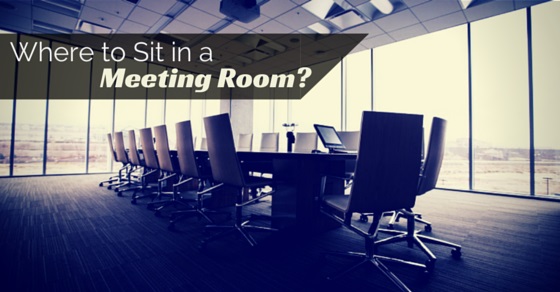You’re sitting in a meeting room directly impacts your efficiency. To participate and be noticed effectively your sitting arrangement in a meeting is significant. Business meetings are occasions for being trained, make interactions and progression. Whether you are going to lead the meeting or the one who will follow, the meeting room symbolizes an area of nonverbal communication set up that could boom or disrupt your aspirations. The seat which you choose to sit will persuade where you stand. Following mentioned is a guide for sit-down presentations with a good body language.
When choosing a seat in the meeting room keep in mind you even choose the role you are to play in the meeting, thus below are few tips to choose the seat tactically.
15 Tips to Show Good Body Language During Meetings :
1. Be punctual:
If you are planning on influencing in the meeting the best habit to practice is to be early. The most basic reason is choosing a seat. If you are late you will be only getting to sit in the free spots available which snatches away your greatest opportunity on influencing. You need to observe the setting of the meeting room and then choose the best seat. For all this matter you need to arrive before time.
2. Authoritative seat:
The head of the table is where the one who conducts the meeting is seated. It is the place where everyone can see you. In this seat one can facilitate the flow of communication in a best way. When you are sitting in this seat your task is to delegate work and conclude the discussion. Whether you utilize the seat to encourage people or to exercise personal power depends on you. However as the authority and decision maker if you choose a weaker position then your meeting will not be as effective.
3. Best view:
If you are not the head it is preferred you switch to another seat as it is disrespectful to sit on the seat of power. Rather you can sit in a seat with the safest back area, and the best sight of the windows, doors, other meeting attendees, projection or video screen. You should make sure you have the best view of everything to not miss any part. To make most of the eye interactions choose the best view seat.
4. Sit in clear view to influence:
Eye contact is an essential tool in a meeting and for influencing. If you anticipate influencing someone in specific, sit where you can directly view each other and exchange eye contacts. Sit in a seat close to the Chair so that you are in the field of view to that specific someone. Some of the control of the Chair may wear down on you. Make as much as nonverbal communication as possible. Pick the best seat which keeps you high and visible to all, so that you do not have to look up or twist and turn your head as though you are pleading attention.
5. Other powerful personalities:
There are chances of other powerful personalities to attend the meeting other than the Chair. Be careful around such people. When you sit close to the people who are in command you tend to get some of the attention. It might aid depending upon your aims. Be selective and aware on the choice of seat near such influencing people.
6. Sit near potential networks:
When you want to network with someone it is best to sit close to such influencers. You can make a quick chat with them when there is a meeting break or after the completion of the meeting. Sitting near the door side makes it easier to launch a quick chat after the meeting. Make sure you are not disturbing others in the bargain of networking with influencers thus choose a seat close to them.
7. Opposite of the Chair:
You can choose to sit opposite the Chair if you are a guest or to place a topic against the Chair or in some disagreement. You can also be sitting opposite to have visibility to all and present certain aspects of the plan. It is another powerful seat from which one can disagree to the Chair. If you sit here you are placed opposite to the Chair in a discussion. A smart authority may not keep an opposite seat for saving disruptive decisions or change the configuration of seats.
8. Middle seats:
The middle seats of the table can be utilized if you have very fewer ideas to present. You sit here since you want to dodge to be heard. Sit here if you are new to the group and if you would like to quietly comprehend the situation. If you want to be overlooked it is an apt seat. It is fine to be seated in the middle of the table if you merely want to get knowledge of the discussion and have no such items to be produced.
9. Presentation screen:
If you are to show your presentation and it is while you are seated, the best option would be to sit close to the screen where your presentation is being displayed. If you choose to be sitting back, away from the presentation screen thinking this will get the attention to the presentation, it indeed will get all the focus of the people there to the presentation and not your explanation. The important deliberation which you prepared will go useless unless you plan to sit close to the presentation screen. When you sit close to the screen or in front of it, you are exposed for making sufficient eye contact and elucidate to the attendees face to face.
10. To build trust:
If you are targeting few of the leaders who are in the meeting and our need to gain their trust, sit on their right-hand side. It generates a feeling of credibility. You can interact with the person and exchange few ideas and opinions. Fortunately if few of them match with the person, you will be gaining his trust and it will facilitate your prospects. You are going to build a relationship of trust and network with dominant people by just sitting on their right.
11. Active discussion:
You can take the seats in the middle section or those at the ends when you are to involve in a discussion intensively. When you sit along with the leader by his side, he will not notice you. The corner seats are where he is going to focus and anticipate answers from. He gets a good view of the corner seats and the middle ones and considers person at his side to agreeing with his hypothesis, so he ultimately chooses middle section people to get more assumptions and get to the depths of the discussions.
12. Confrontation:
When you are discussing your ideas with your coworkers or some other influential person, it is most likely you sit confronting that particular person. If the person is sitting in the middle section of the table you also choose the middle section and the seat opposite him. This is to denote you are contradicting to his suppositions in the meeting. It is the basic way for nonverbal presentation of contrasting ideas. The other attendees will visibly find it clear that you are in a confrontation.
13. Alignment:
If you sit next to your boss or the Chair it reflects that you are in agreement with his suggestions. When you are sitting next to someone who is opposite the leader across the table displaying contradictory suggestions you are then in agreement with this person. When you sit next to a person you are aligned with the ideas of that person. You are seen as supporting member. So thus you know where you should be sitting when you are disagreeing or want to support a person.
14. Avoid seats close to windows:
The meeting needs your full attention and focus. You can always look out for a soothing sight to keep your senses calm. However when you sit close to a window, it may become a constant distraction for you. Most of the people might think that it can never happen to them and that they are very focused and good at concentrating. Yet there are chances that you are fully distracted from the meeting because you were looking out from the window. You might miss out on a very significant point or miss out something you were eager to clear your doubts of.
15. Where would you like me to sit?
You can ask your host or the leader of the meeting to guide on where to sit. You will have to wait until he arrives. This will allow the leader to fix a place for you and organize the seating arrangements in a way that is comfortable and in a configuration that will lodge all the attendees of the meeting, even for those who are yet to arrive.
Get most of the interactions by placing yourself high sitting straight and looking each one in the eye. Choose the seats according to above situations and get maximum chances for influencing others. Network with the powerful people you sit with. The best seat you choose for each meeting will pave the way for a successful career and a productive discussion. Be very perceptible to each and every person present to create a vast impression.









































